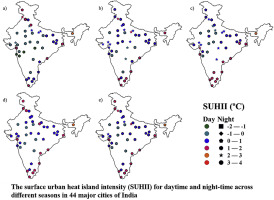当前位置:
X-MOL 学术
›
J. Environ. Manag.
›
论文详情
Our official English website, www.x-mol.net, welcomes your
feedback! (Note: you will need to create a separate account there.)
Anthropogenic forcing exacerbating the urban heat islands in India.
Journal of Environmental Management ( IF 8.0 ) Pub Date : 2019-12-24 , DOI: 10.1016/j.jenvman.2019.110006 Sarath Raj 1 , Saikat Kumar Paul 2 , Arun Chakraborty 1 , Jayanarayanan Kuttippurath 1
Journal of Environmental Management ( IF 8.0 ) Pub Date : 2019-12-24 , DOI: 10.1016/j.jenvman.2019.110006 Sarath Raj 1 , Saikat Kumar Paul 2 , Arun Chakraborty 1 , Jayanarayanan Kuttippurath 1
Affiliation

|
Urban heat island (UHI) phenomena is among the major consequences of the alteration of earth's surface due to human activities. The relatively warmer temperatures in urban areas compared to suburban areas (i.e. UHI) has potential health hazards, such as mortality due to high temperatures and heat waves. In addition, UHI situation demands more energy (e.g. fans and air-conditioners) that would trigger greenhouse gas emissions. Studies on UHI intensity help to assess its impact on urban population, city planning, and urban health planning. This is particularly important for a country like India, where 32% people (~7% of total world population), live in urban areas. We conducted a detailed study on surface UHI intensity (SUHII), which is the difference between urban and surrounding rural land surface temperatures, across all seasons in 44 major cities of India, which shows that mean daytime SUHII is positive (up to 2 °C) for most cities, as analysed from satellite temperature measurements for the period 2000-2017, in contrast to previous studies. However, although statistically insignificant, most cities show a positive trend in SUHII for monsoon and post-monsoon periods, but negative for winter and summer seasons. The increasing night-time SUHII in all seasons for most cities suggest increasing trend in temperature in cities due to the impact of the rapid urbanisation, and thus, suggesting the influence of anthropogenic forcing on SUHII. This is also supported by the analysis of aerosols, night lights, precipitation and vegetation in the study regions. Therefore, this study shall aid planning and management of urban areas by giving insights about the effects of nature and intensity of development, land cover and land use mix and the structure of cities on SUHII.
中文翻译:

人为强迫加剧了印度的城市热岛。
城市热岛(UHI)现象是由于人类活动而改变地球表面的主要后果之一。与郊区(即UHI)相比,城市地区的温度相对较高,具有潜在的健康危害,例如高温和热浪导致的死亡。此外,UHI情况需要更多的能源(例如风扇和空调),这些能源会触发温室气体排放。关于UHI强度的研究有助于评估其对城市人口,城市规划和城市卫生规划的影响。对于像印度这样的国家而言,这一点尤其重要,那里有32%的人口(约占世界总人口的7%)居住在城市地区。我们对地面UHI强度(SUHII)进行了详细研究,SUHIII是城市和周围农村土地表面温度之间的差异,在印度44个主要城市的所有季节中,所有季节的平均白天SUHII均呈正值(最高2°C),这是根据2000-2017年期间的卫星温度测量结果得出的,与之前的研究相反。但是,尽管从统计意义上讲微不足道,但大多数城市在季风和季风后期间的SUHII趋势呈正趋势,而在冬季和夏季则呈负趋势。大多数城市各个季节夜间SUHII的增加都表明,由于快速城市化的影响,城市温度呈上升趋势,因此,暗示了人为强迫对SUHII的影响。对研究区域内的气溶胶,夜灯,降水和植被的分析也支持了这一点。所以,
更新日期:2019-12-27
中文翻译:

人为强迫加剧了印度的城市热岛。
城市热岛(UHI)现象是由于人类活动而改变地球表面的主要后果之一。与郊区(即UHI)相比,城市地区的温度相对较高,具有潜在的健康危害,例如高温和热浪导致的死亡。此外,UHI情况需要更多的能源(例如风扇和空调),这些能源会触发温室气体排放。关于UHI强度的研究有助于评估其对城市人口,城市规划和城市卫生规划的影响。对于像印度这样的国家而言,这一点尤其重要,那里有32%的人口(约占世界总人口的7%)居住在城市地区。我们对地面UHI强度(SUHII)进行了详细研究,SUHIII是城市和周围农村土地表面温度之间的差异,在印度44个主要城市的所有季节中,所有季节的平均白天SUHII均呈正值(最高2°C),这是根据2000-2017年期间的卫星温度测量结果得出的,与之前的研究相反。但是,尽管从统计意义上讲微不足道,但大多数城市在季风和季风后期间的SUHII趋势呈正趋势,而在冬季和夏季则呈负趋势。大多数城市各个季节夜间SUHII的增加都表明,由于快速城市化的影响,城市温度呈上升趋势,因此,暗示了人为强迫对SUHII的影响。对研究区域内的气溶胶,夜灯,降水和植被的分析也支持了这一点。所以,











































 京公网安备 11010802027423号
京公网安备 11010802027423号